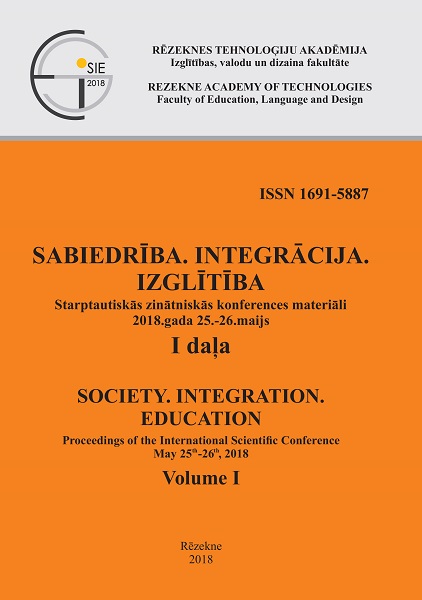EFFECTIVENESS OF THE DIGITAL IMAGE LIBRARY CASES IN HUMAN ANATOMY STUDIES
DOI:
https://doi.org/10.17770/sie2018vol1.3305Keywords:
Anatomage, Digital Image Library, effectiveness, Human Anatomy, study processAbstract
In several education technologies and options for teaching and studies one of the alternatives is the Anatomage 3D virtual dissection table with included Digital Image Library. The aim of this study was to observe the effectiveness of the Digital Image Library cases in Human Anatomy studies at Rīga Stradiņš University (RSU). In 2017 it was used every second week during the autumn`s practical classes on several occasions to show variety of interesting and many unique human anatomy cases, abnormalities, diseases and detailed sectional scans. As methods for collecting data were used discussions between students groups and survays. The sample included 100 students and 1 Human Anatomy tutor. The findings suggest that the Digital Image Library cases are very interactive and effective tools of the teaching and studies in Human Anatomy at RSU. This is a new form of the communication between students, tutor, virtual reality of the body systems and it provides a lot of digital materials that develop relationships between basic and clinical study subjects.References
Anand, M. K. & Singel, T. C. (2014). A comparative study of learning with “anatomage” virtual dissection table versus traditional dissection method in neuroanatomy. Indian Journal of Clinical Anatomy and Physiology, 4(2),177–180.
Azer, S. A. & Azer, S. (2016). 3D Anatomy Models and Impact on Learning: A Review of the Quality of the Literature. Health Professions Education, 2, 80–89.
Brazina, D., Fojtik, R. & Rombova, Z. (2014). 3D Visualization in Teaching Anatomy. Social and Behavioral Sciences, 143, 367–371.
Custer, T. & Kimberly M. (2015). The Utilization of the Anatomage Virtual Dissection Table in the Education of Imaging Science Students. Journal of Tomography & Simulation, 1(1), 1–4.
Grignon, B., Oldrini, G. & Walter, F. (2016). Teaching medical anatomy: what is the role of imaging today? Surgical and Radiologic Anatomy, 38(2), 253–260.
Hopkins, R., Regehr, G. & Wilson, T. D. (2011). Exploring the changing learning environment of the gross anatomy lab. Academic Medicine, 86(7), 883–888.
Hoyek, N., Collet, C., Di Rienzo, F., De Almeida, M. & Guillot, A. Effectiveness of three-dimensional digital animation in teaching human anatomy in an authentic classroom context. (2014). Anatomical Sciences Education, 7(6), 430–437.
Kerby, J., Shukur, Z. N. & Shalhoub, J. (2011). The relationships between learning outcomes and methods of teaching anatomy as perceived by medical students. Clinical Anatomy, 24(4), 489–497.
Khot, Z., Quinlan, K., Norman, G. R. & Wainman, B. (2013). The relative effectiveness of computer based and traditional resources for education in anatomy. Anatomical Sciences Education, 6(4), 211–215.
Kurt, E., Yurdakul, S. E. & Ataç A. (2013). An Overview of the Technologies Used for Anatomy Education in Terms of Medical History. Social and Behavioral Sciences, 103, 109–115.
Lufler, R. S., Zumwalt, A. C., Romney, C.A. & Hoagland, T. M. (2010). Incorporating radiology into medical gross anatomy: Does the use of cadaver CT scans improve students’ academic performance in anatomy? Anatomical Sciences Education, 3, 56–63.
Medical education. Available at http://www.anatomage.com/medical-applications/edical-studies. Accessed on 8 June 2016.
Mutalik, M. & Belsare, S. (2016). Methods to learn human anatomy: perceptions of medical students in paraclinical and clinical phases regarding cadaver dissection and other learning methods. International Journal of Research in Medical Sciences, 4(7), 2536–2541.
Paech, D., Giesel, F. L., Unterhinninghofen, R., Schlemmer, H. P., Kuner, T. & Doll S. (2017). Cadaver-specific CT scans visualized at the dissection table combined with virtual dissection tables improve learning performance in general gross anatomy. European Radiology, 27(5), 2153–2260.
Rizzolo, L. J., Rando, W. C., O`Brien, M. K., Haims, A. H., Abrahams, J. J. & Stewart, W. B. (2010). Design, Implementation, and Evaluation of an Innovative Anatomy Course. Anatomical Sciences Education, 3(3),109–120.
Sugand, K., Abrahams, P. & Khurana, A. (2010). The anatomy of anatomy: A review for its modernization. Anatomical Sciences Education, 3, 83–93.
Tanasi, C. M., Tanase, V. I. & Harsovescu, T. (2014). Modern Methods Used in Study of Human Anatomy. Social and Behavioral Sciences, 127, 676–680.
Zarghani, M., Eskrootchi, R., Hoseini, A., Noorishadkam, M., Golmohammadi, A. & Mostaghaci, M. (2015). Virtual Library: An essential component of virtual education. Journal of Medical Education and Development, 10(1), 36–46.






